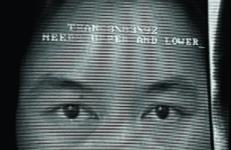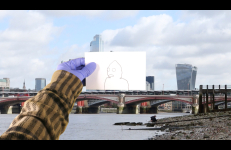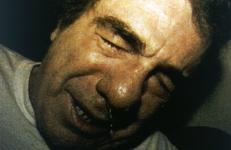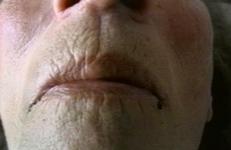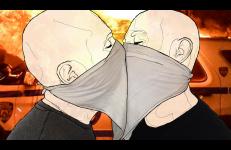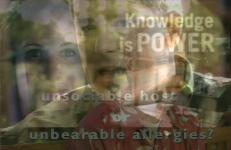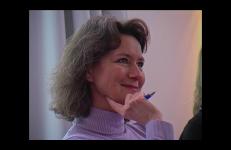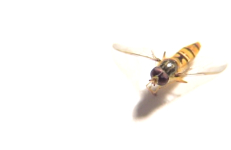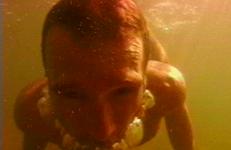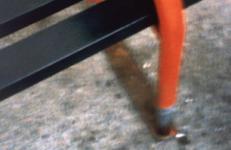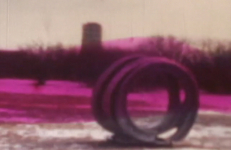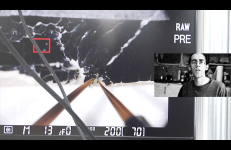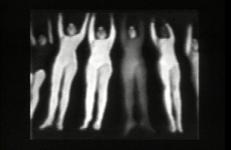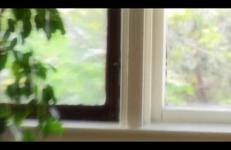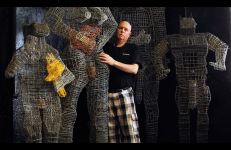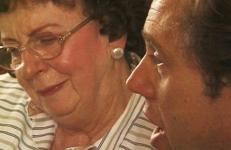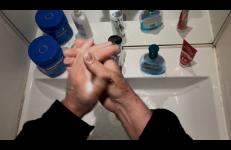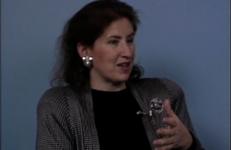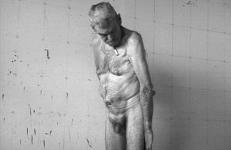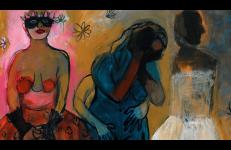Are gender outlaws considered the new biological terrorists seeking weapons of mass bodily destruction? OPERATION INVERT compares the different regulations mediating botox-related plastic surgery and gender reassignment "sex change." Historical medical assessments of the invert (homosexual and transsexual) "condition" reveal seemingly outdated absurdities about outsider deviance. Nonetheless, current institutional loopholes governing gender re-assignment surgery suggest a fresh resurgence of loony pathology and diagnosis.
Health
The artist visits with seven cosmetic surgeons specializing in blepharoplasty (cosmetic eyelid creasing surgery) in the West Hollywood/Beverly Hills area for initial consultation sessions. The doctors demonstrate different reshaping options and comment upon the prevalence and success rates for different Asian nationalities while Tran presents statistics and facts in text that frame the consultations.
This title is also available on Tran, T. Kim-Trang: The Blindness Series.
The expansive cycles of time vs. the ever smaller circles of life under lockdown. Includes: a journey to the river, some rat facts, more adverts, anagrams, and a noticeable build up of ideas.
Third video in The Variations cycle.
Christmas Eve. A man alone finds someone he can talk to.
"Pétit Jesus, a man speaks in his native French about his loneliness, his desperate need for love. The content of his speech is a poem of his own creation which he holds in his hand (off-camera) and from which he recites. With tears and snot pouring from his face, and a voice wracked with sobs, his "performance" is compelling in its rawness, its stark honesty."
--Scott McLeod, Curator, Moving Stills, Gallery 44, Toronto, 2000
A Prayer For Nettie dramatizes the death of an elderly woman who was Cumming’s photographic model from 1982 to 1993, presenting an improvised series of prayers and memorials for Nettie Harris by people who knew her, and some who did not. In its ambiguous mix of tenderness and aggression, A Prayer For Nettie extends the traditions of the grotesque and the absurd. The fervent prayers of the actors are undermined by indifference, forgetfulness, and the presence of the camera. In the end, comedy turns the tables on piety and remembrance as Nettie looks up from the grave.
Primavera is a frenetic experimental animation that documents the pandemic and the Black Lives Matter protests as they intersect in springtime Brooklyn. Shot during isolation on a phone, the video explores the effects of imposed distance on touch and intimacy, the proximity of an invisible virus and invisible deaths, and the revolt against the racist, corrupt systems that commodify, exploit and render their most vulnerable citizens disposable.
pulse pharma phantasm is a frame by frame weaving of nine different pharmaceutical television commercials into a pulsating hallucination of worry and relief.
Shot during an NLP (neuro-linguistic programming) seminar in Berlin, a group fluxuates between guided meditation and discussion on consciousness and self-acceptance. Neuro-linguistic programming is a set of techniques and beliefs that are used primarily towards personal development. NLP is based on the idea that mind, body, and language create an individual's perception of the world, and an individuals behaviors can be changed by "perceiving and feeling yourself". Rapport focuses on the staging of the self that takes place during this kind of group therapy.
Sea In The Blood is a personal documentary about living with illness, tracing the relationship of the artist to thalassemia in his sister Nan, and AIDS in his partner Tim. At the core of the piece are two trips. The first is in 1962, when Richard went from Trinidad to England with Nan to see a famous hematologist interested in her unusual case. The second is in 1977 when Richard and Tim made the counterculture pilgrimage from Europe to Asia. The relationship with Tim blossomed, but Nan died before their return.
A conversation about marriage and horses between two unseen men.
This title is also available on Donigan Cumming: Controlled Disturbance and Donigan Cumming: Four Short Pieces.
Super 8 footage layered with Sharpie marked lines and circles obscuring the image illustrates the story of the Cuthand’s experience with temporary episodes of migraine related blindness and his cousin’s self induced blindness later in life. Paralleling the experience of Blindness with Mental Illness, Cuthand deftly elucidates that any of us could lose any of our abilities at any time.
Originally commissioned by the Harvard Art Museums in response to the life and work of David Wojnarowicz, Survivor’s Remorse looks at how both art and bodies are maintained and the socio-economic influences that create a chasm between the value of things and people. This work examines the resources dedicated to the maintenance and care of artworks versus (artists) lives, especially those marginalized by illness or identity.
Based on accounts of girlhood anorexia, Swallow unravels the masked and shifting symptoms that define clinical depression. With a densely layered soundtrack, humorous and painful scenes of potential psychological breakdown reveal a critical loss of meaning, and the failure to diagnose mental illness. Weaving narrative, documentary, and experimental strategies, Swallow intimately traces the awkward steps from unacknowledged depression to self-recognition.
Recently I found myself rising from a forced landing on the floor after being catapulted into the air by an exercise machine and bouncing off the dresser. Through raccoon eyes, the effect of falling on my face, I squinted into the fog-filled room of my present, stumbling about apprehensively, my long-term memory scrambled and short-term memory severely inhibited. My once reliable body and memory were teetering on the brink of self-betrayal.
That Which Is Possible is a portrait of a community of painters, sculptors, musicians and writers making work at the Living Museum, an art-space on the grounds of a large state-run psychiatric facility in Queens, New York. Shot over the course of two years and structured across the arc of a day, the film observes with an intimate lens and unspools like a musical, both bracing and tender. That Which Is Possible explores the liberatory and reparative functions that creative action has for a group of artists drawn together by shared struggle.
Threads of Belonging depicts the daily life of Layton House, a fictional therapeutic community, where doctors live with their schizophrenic patients. The characters and events of Layton House were drawn from writings of the anti-psychiatry movement, whose most famous proponent was R.D. Laing. In this film we see experimental therapies, power struggles, and the individual arcs of mental illness converge, as a community struggles to understand itself and determine its destiny.
Fred Tomaselli’s mosaics and collages compose patterns and images that suggest ancient global influences. His materials, however, are products of modern consumption, addiction, bodily abuse, and pleasure: pills, nicotine patches, bandages, and the like. The surfaces are coated with a lacquered veneer, making these mundane sources of highs or healing gleam. Interview by James Rondeau. A historical interview originally recorded in 1999 and re-edited in 2007.
The artist follows the British government's advice while self-isolating at home during the COVID-19 lockdown.
This feature-length experimental narrative, about women’s relationships to new reproduction technologies and genetic engineering, combines documentary interviews with field experts and a science fiction segment depicting stories of in-vitro fertilization and other methods. Underexposed: The Temple Of The Fetus examines ways the news media shapes perceptions and social attitudes towards medical topics.
Carole S. Vance is an anthropologist and writer and Associate Research Scientist of Public Health and Director of the Program for the Study of Sexuality, Gender, Health and Human Rights at Columbia University. She has written extensively on sexuality and public policy, as well as issues of gender, health, and medical anthropology. Her books include Pleasure and Danger: Exploring Female Sexuality (1984 and 1993) and Caught Looking: Feminism, Pornography, and Censorship (1988). Interview by Carole Tormollan. A historical interview originally recorded in 1989.
The comings and goings of the late underground filmmaker, Curt McDowell—and the people and activities that came and went along with him—are the themes that run through this existential diary of daily life. McDowell was dying from AIDS-related illnesses during the production of the diary.
“An elegy for McDowell, the videowork captures Kuchar’s mournful remembrances of his long-lasting friendship with the young filmmaker. But it also has the inquisitive charm, perverse humor, and quirky candor that places Kuchar’s visual expressions in a gritty niche all their own.”
Voice: off is the autobiography of a forgotten man. Brain damaged, body violated, emotions crushed, Gerry who rarely spoke has now lost the power of speech. The video camera is his prosthesis and he borrows the memories of people who no longer need them. How can this be a comedy? It is. "Donigan Cumming looks at the violence of time that damages the body and exhausts memories. For the main character in Voice: off, Gerald, the illness is incurable. Two cancers are at work, one of which is attacking his throat.
We Were Hardly More Than Children tells an epic tale of an illegal abortion, as lived by two women on a perilous journey through a world that has little concern for their survival.
Paintings by Diane Messinger.
Music by Renato Umali.
Lena and friend: Flora Coker and Cecelia Condit.
An experimental documentary video project about individuals who have been transformed from so called “ordinary” citizens into activists, Witness To The Future seeks connections that unite people of all cultures, communities, races, and economic classes as they struggle for environmental and social change.





